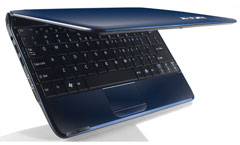
With all the buzz surrounding netbooks, it seems as if they’ve been around forever. In reality, though, they’re youngsters in the great scheme of things. As such, their characteristics are still in flux, their makers still casting about for the best mix of form and power. Acer, with the introduction of its Aspire One AO751h model, is advancing the netbook closer to that best mix.
The unit, which sells in the US$350-$550 price range, depending on the configuration of its memory, processor and battery, pleasantly addresses two nagging problems with netbooks — the size of their displays and keyboards.
This Aspire One model has a fetching 11.6-inch backlit LCD display. Acer’s CrystalBrite technology makes the screen bright and sharp. Its colors are dazzling.
Maximum resolution for the model is 1,366 x 768 pixels. That translates into very small type on the screen, which may challenge the sight of some users. On the other hand, it makes for excellent viewing of photos and video.
The display’s wide aspect ratio (16:9) is very comfortable to work with. Most Web pages can be viewed without horizontal scrolling. The screen can also cozily accommodate other common applications–such word processing and spreadsheets.
Large Keys
The Acer One’s larger screen is not only easy on the eyes, but it allows the unit’s designers to beef up the size of the netbook’s keyboard. Keyboard size has been a favorite target of netbook critics.
The AO’s letter keys are spacious. They measure 5/8 x 5/8 inches. By comparison, the keys for my desktop PC are only about 1/2 x 1/2 inches.
The unit’s oversized keys — left and right shift, enter, backspace, caps lock and tab — are ample, not the truncated versions endemic to downsized keyboards.
As with most thin computers — this nettie is only an inch thick — the stroke distance of keys isn’t as deep as it is on a desktop keyboard, but the overall action of the clavier was very good and suitable for extended typing sessions.
A pleasing perquisite with the keyboard is its sensible cursor keys. Placed in an inverted T in the right corner of the keyboard, they also perform in shifted Fn mode as volume and brightness controls.
That convenient arrangement is further enhanced by placement of the page up/home and page down/end keys on either side of the up arrow.
Tricky Trackpad
Navigation on the screen is performed via a trackpad. Left and right clicking is performed with a bar below the pad.
The bar takes some getting used to. That’s because operators accustomed to striking a bar at any point along its surface to activate a response will be surprised to find that only the end points of the bar accomplish anything. Pressing the left end of the bar is the equivalent of a left mouse click; the right end, a right click.
Moreover, the bar is very close to the pad. When using two fingers–one for clicking, one for controlling the cursor–the clicking finger can sometimes invade the pad and interfere with movement of the cursor.
My review unit was based on an Intel Atom processor running at 1.33 GHz and had 1GB of RAM. Its performance was good with a range of applications.
Start-Up Times
An issue that seems to be getting lost as more and more netbooks enter the market is startup speed. If one of the reasons to be for netbooks is quick access to “the cloud,” then fast startup times should be an important consideration.
The Aspire One runs under Windows XP Home Edition. Average startup time was about a minute. That’s not too bad. Nevertheless, by contrast, the same machine running under Presto, which is based on Linux, booted in about 13 seconds.
There was a similar gap in shutdown times. Windows took 31 seconds to go cold; Presto, three seconds.
Good Battery Life
Since netbooks are designed to appeal to mobile users — users not always close to a wall socket — battery life is an important issue.
Our Aspire One has a six-cell battery pack. It didn’t get the eight hours touted by Acer, but it did get more than 6.5 hours on a single charge, which more than met our mobile requirements during the course of this review.
One drawback to using the six-cell battery is that it protrudes from the back of the unit. That mars the sleek machine’s graceful lines, but, in my opinion, the trade-off for the extra power was worth it.
Netbook With Laptop Comfort
The AO has both a 10.100 Mbps Ethernet port and WiFi b/g connectivity.
Along with its network port, the unit has three USB ports, a VGA port for an external monitor and headphone-speaker-line-out and microphone jacks.
It even has a digital card reader. That’s handy for quickly transferring photos from a digital camera to the computer.
The unit also has a built-in digital microphone to support its built-in Web cam.
For keyboard jocks looking for a netbook that’s as comfortable to use as a laptop and good looking and stylish to boot, the Acer Aspire One fits the bill admirably.






















































